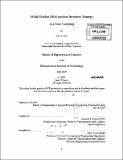Multi-echelon multi-product inventory strategy in a steel company
Author(s)
Iocco, Juan D. (Juan Domingo)
DownloadFull printable version (47.53Mb)
Other Contributors
Massachusetts Institute of Technology. Engineering Systems Division.
Advisor
Amanda J. Schmitt.
Terms of use
Metadata
Show full item recordAbstract
This thesis examines a distribution multi-echelon production-inventory system subject to stochastic demand in the steel industry. The sponsor company, Ternium (a South American steel producer), needs to provide short service times under low inventory costs. The goal of this thesis is to generate a model and conclusions to determine where and how much inventory to hold to satisfy a required service level. Risk pooling is an important consideration for this problem; once a steel product advances in the production process, it has less possibilities of use for different customers. Since distribution stochastic multi-echelon inventory systems have no known optimal formulated solution, algorithms and simulation will be used determine a strategy. The analysis uses simulation as the main method to solve the problem. A distribution multi-echelon model is developed. Different cost scenarios are defined and run. Next, the best set of solutions, defined as the service level-holding cost efficient frontier, is found. To increase the understanding of the problems and provide a better interpretation of the results, we test the sensitivity of the solution and the impact of the input parameters. Later, we explore different ways of solving the problem using alternative modeling methods to determine the base-stock levels. Finally, these solutions are tested with simulation and compared with the best results. Through the analysis, we find that simulation is a powerful tool for finding the best inventory strategy, but the results are very sensitive to cost parameters. (cont.) Modeling allows important saving costs if we compare the best solutions found with the simplest policy used by the company (allocating all safety stock to the echelon closest to the customer). Finally, we demonstrate that some of the alternative modeling methods used to allocate inventory perform well, but simulation is an important complement to test and fine-tune these models.
Description
Thesis (M. Eng. in Logistics)--Massachusetts Institute of Technology, Engineering Systems Division, 2009. Includes bibliographical references (leaves 78-79).
Date issued
2009Department
Massachusetts Institute of Technology. Engineering Systems DivisionPublisher
Massachusetts Institute of Technology
Keywords
Engineering Systems Division.